文化背景知识
导游必背知识点总结

导游必背知识点总结一、历史文化知识点1. 根据不同景点,要了解其历史渊源,如建筑物的兴建时间、文化背景、重大历史事件等。
比如故宫的兴建历史,长城的修建历史,都是必备的知识点。
2. 针对不同的文物古迹,要了解其珍贵程度、保存状况、价值意义等。
比如故宫的珍宝展、兵马俑的发现及修复过程等。
3. 了解当地的传统文化与风俗习惯,比如节日习俗、饮食文化、民俗活动等。
比如在西藏,要了解藏族的宗教信仰、饮食习俗等。
4. 掌握一定的艺术表演和文化活动知识,以便为游客介绍当地的民间歌舞、戏曲表演、手工艺制作等。
二、特色风土人情知识点1. 分别了解不同地区的自然风光特色,比如四川的川西风光、云贵高原、广东的岭南和西湖的风景等。
2. 掌握当地特产的情况,比如云南的普洱茶、四川的蜀锦、北京的景泰蓝等。
3. 了解当地的民间传说和神话故事,可以为游客讲解一些当地的传统神话故事,增加趣味性。
4. 了解当地的民间文化活动,比如节庆活动、宗教信仰等。
例如,在西藏地区了解藏族传统节日和宗教活动。
三、旅游注意事项知识点1. 每个景点都有其独特的旅游注意事项,导游要对这些事项了如指掌。
比如荒漠地区的防晒与水分补给、高原地区的高原反应防范、水域地区的安全意识等。
2. 了解当地的风俗习惯,指导游客尊重当地的风土人情,遵守当地的礼仪习惯。
比如在西部地区,了解当地少数民族的饮食和礼仪。
3. 熟悉当地的特色美食,指导游客品尝当地特色美食,增加旅行的乐趣。
比如在四川了解川菜的特色、在广东了解粤菜的特色。
4. 熟悉当地的购物情况,指导游客了解当地的特产购物场所,帮助游客挑选物美价廉的商品。
以上所提及的知识点只是导游必备的部分知识点,不同的景点和不同的地区还会有更多需要了解的知识。
导游要保持学习的心态,不断充实自己的知识储备,让自己成为一名优秀的导游。
文化背景知识的概念与分类
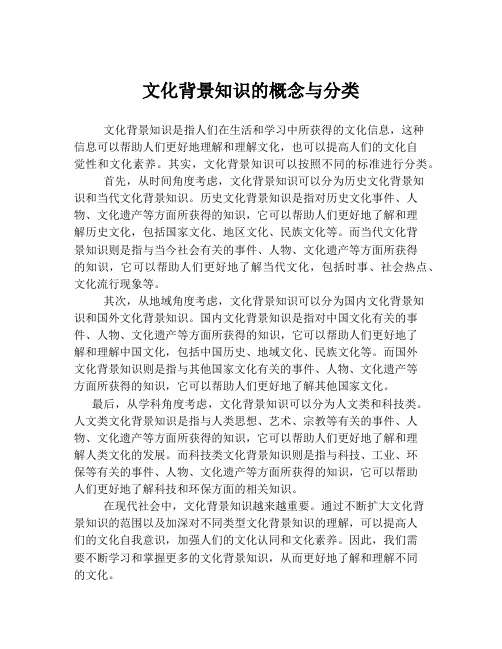
文化背景知识的概念与分类文化背景知识是指人们在生活和学习中所获得的文化信息,这种信息可以帮助人们更好地理解和理解文化,也可以提高人们的文化自觉性和文化素养。
其实,文化背景知识可以按照不同的标准进行分类。
首先,从时间角度考虑,文化背景知识可以分为历史文化背景知识和当代文化背景知识。
历史文化背景知识是指对历史文化事件、人物、文化遗产等方面所获得的知识,它可以帮助人们更好地了解和理解历史文化,包括国家文化、地区文化、民族文化等。
而当代文化背景知识则是指与当今社会有关的事件、人物、文化遗产等方面所获得的知识,它可以帮助人们更好地了解当代文化,包括时事、社会热点、文化流行现象等。
其次,从地域角度考虑,文化背景知识可以分为国内文化背景知识和国外文化背景知识。
国内文化背景知识是指对中国文化有关的事件、人物、文化遗产等方面所获得的知识,它可以帮助人们更好地了解和理解中国文化,包括中国历史、地域文化、民族文化等。
而国外文化背景知识则是指与其他国家文化有关的事件、人物、文化遗产等方面所获得的知识,它可以帮助人们更好地了解其他国家文化。
最后,从学科角度考虑,文化背景知识可以分为人文类和科技类。
人文类文化背景知识是指与人类思想、艺术、宗教等有关的事件、人物、文化遗产等方面所获得的知识,它可以帮助人们更好地了解和理解人类文化的发展。
而科技类文化背景知识则是指与科技、工业、环保等有关的事件、人物、文化遗产等方面所获得的知识,它可以帮助人们更好地了解科技和环保方面的相关知识。
在现代社会中,文化背景知识越来越重要。
通过不断扩大文化背景知识的范围以及加深对不同类型文化背景知识的理解,可以提高人们的文化自我意识,加强人们的文化认同和文化素养。
因此,我们需要不断学习和掌握更多的文化背景知识,从而更好地了解和理解不同的文化。
万圣节文化知识背景

万圣节文化知识背景万圣节,这个充满神秘与奇幻色彩的节日,每年的 10 月 31 日都会在西方国家热闹上演。
对于许多人来说,它是一个可以尽情装扮、狂欢的时刻,但在其背后,却蕴含着丰富的文化知识和历史背景。
万圣节的起源可以追溯到古代凯尔特人的萨温节。
凯尔特人认为,每年 10 月 31 日的夜晚,是一年中阴阳两界的界限最为模糊的时刻,死去的人的灵魂会返回人间寻找生灵替身,以获得重生。
为了吓走这些恶灵,人们会戴上恐怖的面具,点燃篝火,装扮成妖魔鬼怪的样子。
随着时间的推移,基督教的影响逐渐渗透到这个节日中。
11 月 1 日被定为万圣节,也称为“诸圣节”,以纪念所有的圣徒。
而 10 月 31 日的前夜则成为了“万圣节前夜”,也就是我们现在所熟知的万圣节。
在万圣节的传统习俗中,“不给糖就捣蛋”是孩子们最喜欢的活动之一。
他们会穿上精心准备的服装,挨家挨户地敲门索要糖果。
如果主人不给糖,孩子们就会恶作剧一番。
这种习俗一方面是为了延续古代驱邪的传统,另一方面也为孩子们带来了无尽的欢乐。
而万圣节的装扮则是这个节日的一大特色。
人们可以扮成各种各样的角色,从恐怖的吸血鬼、僵尸、女巫,到可爱的卡通人物、超级英雄等等。
这些装扮不仅展示了人们的创意和想象力,也反映了当时的流行文化。
南瓜灯也是万圣节不可或缺的元素。
传说中,有一个名叫杰克的人,因为戏弄了恶魔,死后灵魂既不能上天堂也不能下地狱,只能提着用南瓜做成的灯笼在人间游荡。
于是,人们便将南瓜掏空,刻上恐怖的面孔,做成南瓜灯,放在门口或窗前,以驱赶恶灵。
此外,万圣节还有一些特殊的食物。
比如,用焦糖、苹果制成的“焦糖苹果”,以及形状各异的饼干和糕点。
这些食物不仅美味可口,而且常常被制作成与万圣节主题相关的形状,增添了节日的氛围。
在现代社会,万圣节已经不仅仅是西方国家的节日,它在全球范围内都受到了欢迎。
许多地方都会举办盛大的万圣节派对和活动,吸引着人们的参与。
商家们也会推出各种与万圣节相关的商品,从服装道具到装饰品,应有尽有。
万圣节文化知识背景

万圣节文化知识背景万圣节,这个充满神秘与欢乐的节日,每年的 10 月 31 日都会在西方国家盛大举行。
对于许多人来说,它可能只是一个充满奇装异服和糖果的欢乐派对,但实际上,万圣节背后蕴含着丰富的文化历史和传统。
万圣节的起源可以追溯到古代凯尔特人的萨温节(Samhain)。
凯尔特人认为,每年的 10 月 31 日是夏季结束、冬季开始的日子,也是新旧年交替的时刻。
这一天,他们相信生死的界限会变得模糊,逝去的灵魂会返回人间。
为了避免恶灵的侵扰,凯尔特人会燃起篝火,穿上奇异的服装,模仿恶灵来驱赶它们。
随着时间的推移,基督教传入欧洲后,万圣节逐渐与宗教元素相结合。
11 月 1 日被定为诸圣节(All Saints' Day),用来纪念所有的圣徒。
而 10 月 31 日的前夕则成为了万圣节前夜,也就是我们现在所熟知的万圣节。
在万圣节的传统中,装扮是不可或缺的一部分。
人们会穿上各种各样恐怖、奇特的服装,从吸血鬼、女巫到僵尸、骷髅等等。
孩子们尤其热衷于这个环节,他们会扮成自己喜欢的角色,挨家挨户地敲门说“不给糖就捣蛋”(Trick or Treat)。
如果主人不给糖果,孩子们就会小小的恶作剧一番。
这种习俗既充满了欢乐,也让邻里之间的关系更加亲密。
除了装扮,南瓜灯也是万圣节的标志性象征。
传说有一个名叫杰克的人,他非常吝啬,死后不能进入天堂也不能下地狱,只能在人间游荡。
为了照明,他用挖空的南瓜装上蜡烛,这就是南瓜灯的由来。
如今,人们会精心雕刻南瓜,制作出各种形状各异、表情生动的南瓜灯,放在家门口或窗户上,为节日增添氛围。
万圣节的庆祝活动在不同的国家和地区也有所差异。
在美国,万圣节是一个非常盛大的节日,人们会举办化妆舞会、游行等活动。
在英国,一些古老的城堡和教堂会在万圣节期间举办特别的活动,讲述恐怖故事。
而在爱尔兰,万圣节的传统更加原汁原味,保留了许多古老的习俗和仪式。
此外,万圣节的美食也别具特色。
糖果自然是最受欢迎的,各种形状和口味的糖果让孩子们爱不释手。
历史文化的背景与背景知识

历史文化的背景与背景知识在我们探索世界的历史和文化的时候,了解历史文化的背景和背景知识是非常重要的。
它们帮助我们理解特定时期和地区的文化发展、艺术创作以及社会变迁。
本文将介绍历史文化背景和背景知识的重要性,并通过几个具体的例子展示它们对我们认识世界的影响。
一、历史文化背景的重要性历史文化背景是指某个特定时期或地区的社会、政治、经济等方面的背景情况。
了解历史文化背景有助于我们更好地理解并分析当时的事件和现象。
例如,在研究文艺复兴时期的艺术作品时,了解该时期的经济繁荣、人文主义思潮以及教会的影响等背景知识,有助于我们理解为什么画家们会采用特定的画风和表现方式,以及作品中所传递的深层次意义。
此外,历史文化背景还帮助我们理解各个时期和地域的发展脉络和变化趋势。
通过研究不同历史时期和地区的背景,我们可以观察到社会制度、思想观念、价值观念等方面的变革,并进一步了解不同文化之间的交流和影响。
二、背景知识的影响背景知识是在特定历史时期和地域产生的各类知识和文化现象,包括艺术、文学、哲学、宗教、科技等方面的内容。
具有丰富的背景知识可以帮助我们更好地解读和理解相关的历史文化。
举例来说,在探究古埃及文明时,了解埃及的宗教信仰、法律制度、建筑风格以及墓葬习俗等背景知识对于解读古埃及的艺术品和文物至关重要。
只有通过对这些背景知识的了解,我们才能更准确地理解埃及金字塔的作用、法老的权力象征以及艳丽的壁画中所呈现的神秘符号。
背景知识还有助于我们培养批判性思维和文化敏感性。
通过对历史文化背景的研究,我们可以从多个维度审视和评估文化现象,并且更好地理解不同文化之间的差异和互动。
这种文化敏感性不仅拓宽了我们的视野,还有助于增进跨文化交流和理解。
三、历史文化背景与背景知识的应用1. 艺术研究在研究艺术作品时,了解其所处的历史背景和文化背景是不可或缺的。
通过对艺术作品的背景知识的深入了解,我们可以更好地理解艺术家的灵感来源、表达意图以及作品所反映的社会观念和审美价值。
中国城市文化要素背景知识
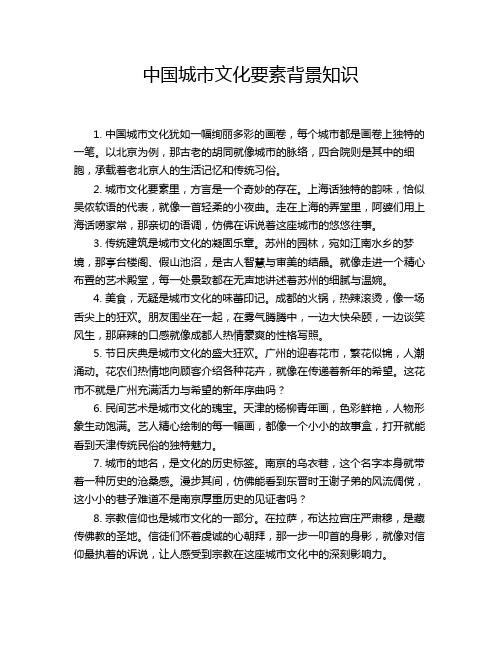
中国城市文化要素背景知识1. 中国城市文化犹如一幅绚丽多彩的画卷,每个城市都是画卷上独特的一笔。
以北京为例,那古老的胡同就像城市的脉络,四合院则是其中的细胞,承载着老北京人的生活记忆和传统习俗。
2. 城市文化要素里,方言是一个奇妙的存在。
上海话独特的韵味,恰似吴侬软语的代表,就像一首轻柔的小夜曲。
走在上海的弄堂里,阿婆们用上海话唠家常,那亲切的语调,仿佛在诉说着这座城市的悠悠往事。
3. 传统建筑是城市文化的凝固乐章。
苏州的园林,宛如江南水乡的梦境,那亭台楼阁、假山池沼,是古人智慧与审美的结晶。
就像走进一个精心布置的艺术殿堂,每一处景致都在无声地讲述着苏州的细腻与温婉。
4. 美食,无疑是城市文化的味蕾印记。
成都的火锅,热辣滚烫,像一场舌尖上的狂欢。
朋友围坐在一起,在雾气腾腾中,一边大快朵颐,一边谈笑风生,那麻辣的口感就像成都人热情豪爽的性格写照。
5. 节日庆典是城市文化的盛大狂欢。
广州的迎春花市,繁花似锦,人潮涌动。
花农们热情地向顾客介绍各种花卉,就像在传递着新年的希望。
这花市不就是广州充满活力与希望的新年序曲吗?6. 民间艺术是城市文化的瑰宝。
天津的杨柳青年画,色彩鲜艳,人物形象生动饱满。
艺人精心绘制的每一幅画,都像一个小小的故事盒,打开就能看到天津传统民俗的独特魅力。
7. 城市的地名,是文化的历史标签。
南京的乌衣巷,这个名字本身就带着一种历史的沧桑感。
漫步其间,仿佛能看到东晋时王谢子弟的风流倜傥,这小小的巷子难道不是南京厚重历史的见证者吗?8. 宗教信仰也是城市文化的一部分。
在拉萨,布达拉宫庄严肃穆,是藏传佛教的圣地。
信徒们怀着虔诚的心朝拜,那一步一叩首的身影,就像对信仰最执着的诉说,让人感受到宗教在这座城市文化中的深刻影响力。
9. 地方戏曲宛如城市文化的灵魂之音。
西安的秦腔,那高亢激昂的唱腔,犹如黄河之水奔腾而下。
戏院里,演员们全情投入,观众们沉浸其中,这秦腔不就是西安人骨子里那股豪迈劲儿的艺术化表达吗?10. 传统手工艺是城市文化的巧手匠心。
古文阅读的背景知识与文化背景
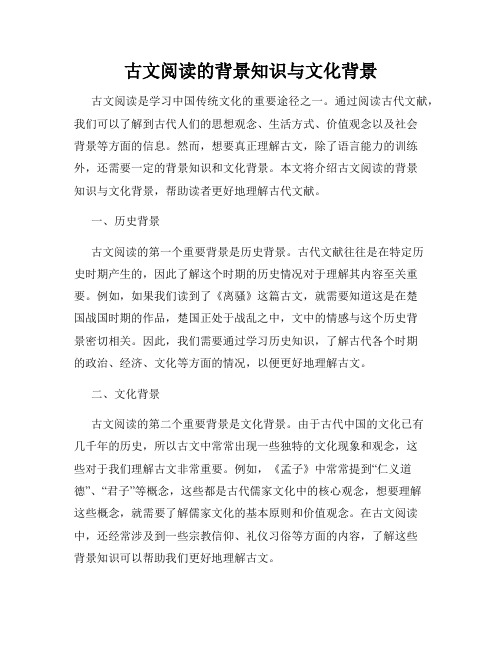
古文阅读的背景知识与文化背景古文阅读是学习中国传统文化的重要途径之一。
通过阅读古代文献,我们可以了解到古代人们的思想观念、生活方式、价值观念以及社会背景等方面的信息。
然而,想要真正理解古文,除了语言能力的训练外,还需要一定的背景知识和文化背景。
本文将介绍古文阅读的背景知识与文化背景,帮助读者更好地理解古代文献。
一、历史背景古文阅读的第一个重要背景是历史背景。
古代文献往往是在特定历史时期产生的,因此了解这个时期的历史情况对于理解其内容至关重要。
例如,如果我们读到了《离骚》这篇古文,就需要知道这是在楚国战国时期的作品,楚国正处于战乱之中,文中的情感与这个历史背景密切相关。
因此,我们需要通过学习历史知识,了解古代各个时期的政治、经济、文化等方面的情况,以便更好地理解古文。
二、文化背景古文阅读的第二个重要背景是文化背景。
由于古代中国的文化已有几千年的历史,所以古文中常常出现一些独特的文化现象和观念,这些对于我们理解古文非常重要。
例如,《孟子》中常常提到“仁义道德”、“君子”等概念,这些都是古代儒家文化中的核心观念,想要理解这些概念,就需要了解儒家文化的基本原则和价值观念。
在古文阅读中,还经常涉及到一些宗教信仰、礼仪习俗等方面的内容,了解这些背景知识可以帮助我们更好地理解古文。
三、词语典故古文中经常使用一些特殊的词语和典故,这些词语和典故在古代文化中有着特定的含义和象征意义。
了解这些词语和典故的来源和含义,可以帮助我们更准确地理解古文。
例如,在《诗经》中有一首《关雎》,其中使用了“关雎”这个词语,它在古代是指关东的人。
如果我们了解这个词语的背景,就能更好地理解诗中的含义。
同样,在阅读古文时,我们经常会遇到一些典故,如“白马非马”、“巧妇难为无米之炊”等,理解这些典故的来源和含义也对于阅读古文至关重要。
总结起来,古文阅读需要我们具备一定的背景知识和文化背景。
只有了解了历史背景,理解了文化背景,了解了词语典故,我们才能更好地理解古文的内涵和意义。
作文写作文化背景大全

作文写作文化背景大全作文是一种表达思想、观点和情感的方式,而文化背景则是作文内容的重要组成部分。
本文将为您提供一份关于作文文化背景的大全,帮助您在写作过程中更好地理解和运用文化背景知识。
1.中国文化背景中国拥有悠久的历史和灿烂的传统文化,其中包括丰富的思想、哲学、艺术和文学。
在作文中,您可以引用中国古代哲学家的名言警句,如“知者不惑,仁者不忧”,来支撑和加强您的观点。
2.西方文化背景西方文化以其理性思维和个人主义而闻名。
您可以通过引用著名西方哲学家的观点,如笛卡尔的“我思故我在”,来强调个人独立思考与自我主张的重要性。
3.古代文化背景古代文化背景包括希腊罗马文化、埃及文明等。
您可以通过引用古代文化中的故事和传说,如希腊神话中的奥德赛故事,来为作文增添一种浪漫和神秘的情调。
4.现代文化背景现代文化背景涵盖时事、科技、流行文化等方面,如互联网的普及、社交媒体的影响等。
您可以引用最新的科技发展和社会现象,如人工智能的应用、网红文化的兴起,来说明作文话题的现实意义和时代背景。
5.地域文化背景不同地域拥有各自独特的文化背景,如中国的东南沿海地区的渔民文化、西部地区的牧民文化等。
您可以根据作文的话题,选择适合的地域文化背景丰富您的论述,如探讨环保问题时,可以引用西部地区牧民的生活习惯和环境观念。
6.宗教文化背景世界各地拥有众多宗教,包括基督教、伊斯兰教、佛教等。
宗教文化背景对于思想、道德、价值观念有着深远的影响。
您可以在作文中运用宗教文化背景,例如通过引用圣经中的寓言或佛经中的故事,来加强您的观点和论证。
通过运用不同的文化背景,您可以为作文增添更多的文化内涵和艺术感,使作文更加丰富多样、有趣生动。
同时,要确保所引用的文化背景信息准确可靠,以提高作文的可信度和文章的质量。
以上是关于作文文化背景的大全,希望这些信息对您的写作有所帮助,并能提升您的作文水平。
祝您写作愉快,取得好成绩!。
学习中的文化理解与背景知识积累
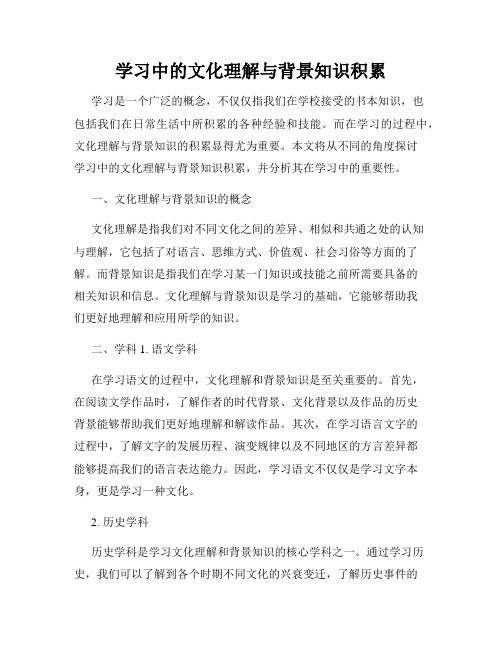
学习中的文化理解与背景知识积累学习是一个广泛的概念,不仅仅指我们在学校接受的书本知识,也包括我们在日常生活中所积累的各种经验和技能。
而在学习的过程中,文化理解与背景知识的积累显得尤为重要。
本文将从不同的角度探讨学习中的文化理解与背景知识积累,并分析其在学习中的重要性。
一、文化理解与背景知识的概念文化理解是指我们对不同文化之间的差异、相似和共通之处的认知与理解,它包括了对语言、思维方式、价值观、社会习俗等方面的了解。
而背景知识是指我们在学习某一门知识或技能之前所需要具备的相关知识和信息。
文化理解与背景知识是学习的基础,它能够帮助我们更好地理解和应用所学的知识。
二、学科1. 语文学科在学习语文的过程中,文化理解和背景知识是至关重要的。
首先,在阅读文学作品时,了解作者的时代背景、文化背景以及作品的历史背景能够帮助我们更好地理解和解读作品。
其次,在学习语言文字的过程中,了解文字的发展历程、演变规律以及不同地区的方言差异都能够提高我们的语言表达能力。
因此,学习语文不仅仅是学习文字本身,更是学习一种文化。
2. 历史学科历史学科是学习文化理解和背景知识的核心学科之一。
通过学习历史,我们可以了解到各个时期不同文化的兴衰变迁,了解历史事件的发生原因和影响,以及历史人物的思想和行为。
这些历史知识可以帮助我们更好地理解当前社会和世界的现状,增强对历史事件的鉴别和思考能力。
3. 地理学科地理学科的学习也需要依托文化理解和背景知识。
通过学习地理,我们可以了解到各个地区的自然环境、人文特点以及经济发展情况,这些知识有助于我们了解地方文化和民俗习惯,促进不同地域之间的交流和了解。
三、文化理解与背景知识在学习中的重要性1. 提高学习兴趣了解文化背景和背景知识能够帮助我们更好地理解学习内容,增加学习的兴趣。
当我们对学习内容有了一定的了解和认知,就能够更好地理解和应用所学的知识,进而激发学习的热情。
2. 加深理解文化背景和背景知识往往是学习内容的补充和延伸,通过学习背景知识能够更全面地理解学习的内容。
地理知识大全:世界各国地理和文化背景介绍

地理知识大全:世界各国地理和文化背景介绍你是否对世界各国的地理和文化背景感兴趣?想要了解不同国家的风土人情和景观?在这篇文章中,我将为你介绍世界各国的地理特点和独特文化,带你一起探索世界的奇妙之处。
1. 中国作为世界上最大的国家之一,中国拥有丰富多样的地理特点和文化背景。
中国境内地域辽阔,拥有高山、平原、河流、湖泊等各种自然景观。
以长江和黄河为代表的众多河流为中国的农业和文明发展做出了巨大贡献。
此外,中国还有世界闻名的长城、故宫和兵马俑等历史遗迹。
中华民族有着悠久的历史和文化传统,如中国的传统节日春节和中秋节,以及功夫、茶道等传统文化艺术形式。
2. 美国美国是一个地域广阔的国家,拥有多样化的地理特点和文化背景。
从东海岸到西海岸,美国的地形变化多样,包括山脉、平原、河流和湖泊。
美国的文化影响力遍及全球,如好莱坞电影、音乐、时尚等。
此外,美国还是技术和创新方面的领导者,拥有众多世界著名的高等教育机构和科研中心。
3. 日本日本是一个岛国,位于东亚,有着独特的地理和文化背景。
日本的自然环境受到保护,拥有美丽的山脉和海岸线。
日本的文化与传统深入人心,如茶道、和服和武士道。
此外,日本以其先进的科技和先进的制造业闻名于世,如汽车和电子产品。
4. 印度印度是一个拥有悠久历史和多样文化的国家。
印度地形复杂,包括山脉、平原、沙漠和河流。
印度是世界上最古老的文明之一,有着丰富多样的宗教和语言。
象棋和瑜伽是印度的传统文化礼物。
此外,印度还是世界上最大的民主国家之一,拥有繁荣的电影产业和软件出口业。
5. 巴西巴西是南美洲最大的国家,也是世界上最大的国家之一。
巴西境内拥有丰富的自然资源,包括亚马逊雨林、河流和美丽的海滩。
巴西是足球的故乡,其舞蹈和音乐也是世界闻名的,如桑巴和博萨诺瓦。
此外,巴西还是拉美最大的经济体之一,拥有发达的农业和工业。
6. 俄罗斯俄罗斯是一个拥有广袤领土的国家,跨越欧亚两个大陆,是世界上最大的国家。
俄罗斯地势辽阔,包括大草原、山脉和湖泊。
培养文化背景知识

培养文化背景知识文化背景知识是指一个人对于各种文化现象的了解和认知,包括历史、文学、艺术、宗教、传统习俗等方面的知识。
拥有丰富的文化背景知识可以让人更好地理解和欣赏各种文化表达形式,拓宽视野,提升思维能力,并且在各个领域中受益匪浅。
培养文化背景知识需要我们广泛涉猎各个领域的文化资源,今天我将为大家介绍一些有效的方法,帮助我们培养和提升自己的文化背景知识。
一、阅读经典文学作品文学作品是一个国家或地区文化的集中体现,通过阅读经典文学作品,我们可以了解到不同时代、不同地域的文化背景和价值观念。
从古代到现代,不同国家的文学作品都有独特的魅力。
比如中国的《红楼梦》、俄罗斯的《战争与和平》,这些作品不仅能够让我们了解对应国家的文化,还能触发我们对于人性与生活的思考。
因此,通过阅读经典文学作品,我们可以拓宽自己的文化视野,了解不同文化的特点和内涵。
二、参观博物馆和艺术展览博物馆和艺术展览是了解文化背景的重要场所,通过观看珍贵的文物、艺术品和展览,我们可以深入了解一个地区或一个民族的文化背景。
博物馆展示的历史文物和艺术品可以帮助我们了解不同时代的文化发展和变迁,艺术展览则可以让我们欣赏到不同艺术形式的精妙之处。
因此,我们可以利用闲暇时间去参观博物馆和艺术展览,丰富自己的文化背景知识。
三、学习历史知识历史是文化背景知识的基石,了解一个国家或地区的历史是理解其文化的重要途径。
通过学习历史,我们可以了解到不同时代的政治、经济、社会背景,以及当时的文化发展和演变过程。
同时,了解历史还可以让我们更好地理解和解读一些文化现象,尤其是那些根植于历史传统中的习俗和观念。
因此,我们可以通过参加历史研究小组、阅读历史书籍或观看历史纪录片等方式,积极学习历史知识,提升自己的文化背景知识。
四、关注当代文化活动了解当代文化活动可以让我们获取到最新的文化动态和趋势,同时也可以让我们了解到文化的多样性和多元化。
通过参与和关注当代文化活动,比如音乐会、戏剧演出、电影放映等,我们可以感受到不同文化艺术形式的魅力,了解当代文化发展的趋势和方向。
文化与社会背景知识

文化与社会背景知识在当今社会,文化与社会背景知识被认为是人们在各种环境中交流、理解和共享的重要元素。
文化和社会的背景知识不仅仅是帮助我们理解世界的基础,还能够促进跨文化交流、推动社会进步和促使个人成长。
本文将就文化与社会背景知识的重要性、人们如何获取和应用这些知识以及如何培养这种知识进行探讨。
一、文化与社会背景知识的重要性1. 促进跨文化交流文化与社会背景知识为人们在不同文化背景下的交流提供了基础。
每个文化都有其独特的价值观、信仰、习俗和语言。
只有了解并尊重各种文化的差异,我们才能更好地与他人建立起互信和共赢的关系。
通过了解其他文化的背景知识,我们能够消除误解和偏见,促进和谐的跨文化交流。
2. 增进理解和共享文化与社会背景知识使人们能够更好地理解和共享信息、经验和观点。
在一个社会中,人们的行为、言语和思维方式都受到特定文化和社会背景的影响。
了解这些背景知识,可以帮助我们在交流和理解他人时更加准确和全面。
同时,文化与社会背景知识也能够促进经验和观点的共享,让我们能够从不同的视角看待问题,拓宽思维的广度和深度。
3. 推动社会进步文化与社会背景知识是推动社会进步的重要力量之一。
通过了解历史、文化和社会的背景知识,我们可以更好地认识到社会变迁的原因和规律,从而为社会发展提供智力支持。
文化与社会背景知识还能够传承和弘扬优秀的文化传统,促进文化的多样性和繁荣,为社会的发展注入活力。
二、获取和应用1. 学习和研究一种获取文化与社会背景知识的有效方式是通过学习和研究。
我们可以通过阅读书籍、报纸、杂志,观看电影、纪录片等途径来获取相关知识。
此外,参加课程、讲座和研讨会,与专家学者交流,也是深入了解文化和社会背景的有效方法。
通过持续学习和不断探索,我们能够获得更加全面和深入的文化与社会背景知识。
2. 积极参与社会积极参与社会是将文化与社会背景知识应用于实践的重要途径之一。
参与社会活动,了解社区、组织和团队的文化和背景,能够增进我们对社会的认识和理解。
人教版教材中的文化背景知识介绍

人教版教材中的文化背景知识介绍人教版教材是中国大陆地区广泛使用的一套教材系列,涵盖了各个学科和年级。
作为教材的编写者,人教版注重将教材内容融入中国文化的元素,以帮助学生更好地理解和掌握知识。
因此,在人教版教材中,我们可以发现许多有关中国文化背景的知识点。
一、历史文化人教版教材中的历史文化内容丰富多样。
比如,在语文课本中,我们会看到一些古代文学作品的片段,如《红楼梦》、《西游记》等。
这些作品是中国文化的瑰宝,通过学习它们,学生们可以了解中国古代社会的风貌、人物形象以及传统价值观念等。
同时,在历史课本中也有一些相关的篇章,如中华文明史、中国近现代史等。
这些篇章涵盖了从古代到现代的历史事件和著名人物,有助于学生对历史的理解和记忆。
二、地理环境人教版教材中的地理环境介绍非常详尽。
通过地理课本,学生们可以了解到中国的地理位置、边界、山川河流等基本情况,同时还可以了解到中国的自然资源分布、气候变化等特点。
此外,在一些科普性的文章中,如关于土壤、气候等话题,也会涉及到与中国相关的知识点,让学生们更好地了解自己所处的国家和地理环境。
三、传统文化中国传统文化是人教版教材中不可忽视的一部分。
在语文课本中,我们可以看到古诗词、传统戏剧、传统艺术等的介绍。
这些文化形式承载了中国人民的文化智慧和情感,通过学习这些文化背景知识,学生们能够更好地理解文学作品的内涵,并能够从中汲取到对生活的积极激励和启示。
四、节日风俗人教版教材中会涉及到中国的一些传统节日和风俗习惯。
比如,在语文课本中,会有关于春节、清明节、中秋节等传统节日的介绍。
在学习这些节日的同时,学生们也会了解到中国人民的传统节日习俗、食品文化、舞蹈音乐等方面的信息。
这样的了解有助于学生们更好地体验中国文化的独特魅力,并增强对传统文化的认同感。
通过人教版教材中的文化背景知识介绍,学生们可以更全面地了解中国的历史、地理、文化传统以及节日风俗等方面的信息。
这种全面的知识体系有助于学生们形成对中国文化的深刻理解,既能够帮助他们更好地掌握教材知识,也能够培养他们的文化素养和全球视野。
阅读课文的背景文化知识
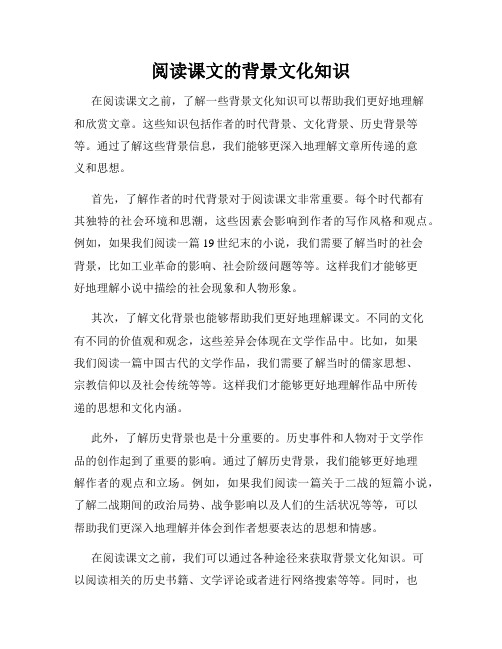
阅读课文的背景文化知识在阅读课文之前,了解一些背景文化知识可以帮助我们更好地理解和欣赏文章。
这些知识包括作者的时代背景、文化背景、历史背景等等。
通过了解这些背景信息,我们能够更深入地理解文章所传递的意义和思想。
首先,了解作者的时代背景对于阅读课文非常重要。
每个时代都有其独特的社会环境和思潮,这些因素会影响到作者的写作风格和观点。
例如,如果我们阅读一篇19世纪末的小说,我们需要了解当时的社会背景,比如工业革命的影响、社会阶级问题等等。
这样我们才能够更好地理解小说中描绘的社会现象和人物形象。
其次,了解文化背景也能够帮助我们更好地理解课文。
不同的文化有不同的价值观和观念,这些差异会体现在文学作品中。
比如,如果我们阅读一篇中国古代的文学作品,我们需要了解当时的儒家思想、宗教信仰以及社会传统等等。
这样我们才能够更好地理解作品中所传递的思想和文化内涵。
此外,了解历史背景也是十分重要的。
历史事件和人物对于文学作品的创作起到了重要的影响。
通过了解历史背景,我们能够更好地理解作者的观点和立场。
例如,如果我们阅读一篇关于二战的短篇小说,了解二战期间的政治局势、战争影响以及人们的生活状况等等,可以帮助我们更深入地理解并体会到作者想要表达的思想和情感。
在阅读课文之前,我们可以通过各种途径来获取背景文化知识。
可以阅读相关的历史书籍、文学评论或者进行网络搜索等等。
同时,也可以向老师或者同学请教,进行讨论和交流。
在积累了足够的背景知识之后,我们再来阅读课文,相信你会有更为深入的理解和感悟。
总之,阅读课文的背景文化知识是提高阅读理解和欣赏能力的重要手段。
通过了解作者的时代背景、文化背景和历史背景,我们能够更好地理解作品所传达的思想和情感。
因此,在阅读课文之前,我们应该花一些时间去了解相关的背景文化知识,以便更好地欣赏和理解课文。
文化常识科普知识大全
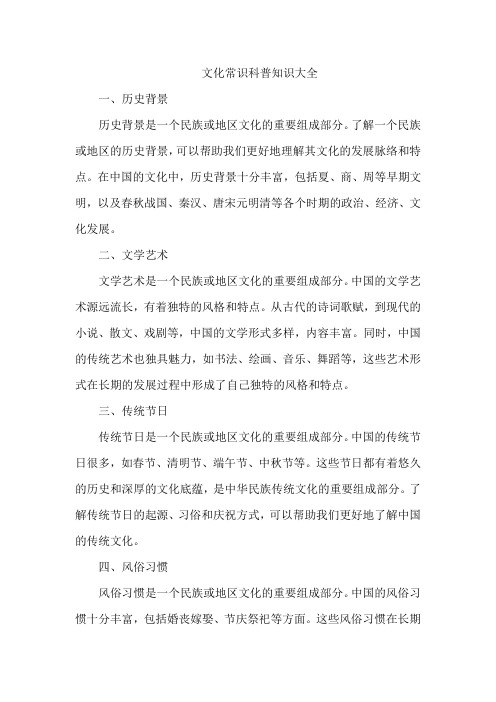
文化常识科普知识大全一、历史背景历史背景是一个民族或地区文化的重要组成部分。
了解一个民族或地区的历史背景,可以帮助我们更好地理解其文化的发展脉络和特点。
在中国的文化中,历史背景十分丰富,包括夏、商、周等早期文明,以及春秋战国、秦汉、唐宋元明清等各个时期的政治、经济、文化发展。
二、文学艺术文学艺术是一个民族或地区文化的重要组成部分。
中国的文学艺术源远流长,有着独特的风格和特点。
从古代的诗词歌赋,到现代的小说、散文、戏剧等,中国的文学形式多样,内容丰富。
同时,中国的传统艺术也独具魅力,如书法、绘画、音乐、舞蹈等,这些艺术形式在长期的发展过程中形成了自己独特的风格和特点。
三、传统节日传统节日是一个民族或地区文化的重要组成部分。
中国的传统节日很多,如春节、清明节、端午节、中秋节等。
这些节日都有着悠久的历史和深厚的文化底蕴,是中华民族传统文化的重要组成部分。
了解传统节日的起源、习俗和庆祝方式,可以帮助我们更好地了解中国的传统文化。
四、风俗习惯风俗习惯是一个民族或地区文化的重要组成部分。
中国的风俗习惯十分丰富,包括婚丧嫁娶、节庆祭祀等方面。
这些风俗习惯在长期的发展过程中形成了自己独特的风格和特点,反映了中华民族的传统价值观和文化精神。
了解中国的风俗习惯,可以帮助我们更好地了解中国的传统文化。
五、饮食文化饮食文化是一个民族或地区文化的重要组成部分。
中国的饮食文化源远流长,有着独特的风格和特点。
中国的饮食注重色香味俱佳,讲究营养搭配和烹饪技巧。
同时,中国还有着众多的地方特色小吃和菜系,如川菜、粤菜、湘菜等,这些特色小吃和菜系在长期的发展过程中形成了自己独特的风格和特点。
了解中国的饮食文化,可以帮助我们更好地了解中国的传统文化。
六、服饰文化服饰文化是一个民族或地区文化的重要组成部分。
中国的传统服饰具有丰富的文化内涵和艺术价值。
从古代的汉服、唐装到现代的中山装、旗袍等,中国的传统服饰在长期的发展过程中形成了自己独特的风格和特点。
走进了解的文化背景

走进了解的文化背景文化,是一个国家、一个地区的灵魂和底蕴,是人们心灵深处抽象而又具体的精神财富。
了解不同文化背景是拓宽自己的视野,增长自己的知识的好方法。
本文将深入探讨走进了解的文化背景,并通过对具体文化背景的分析,让读者对不同文化有一个全面而准确的了解。
一、中国文化背景中国,这个拥有五千年悠久历史的古老国度,其文化背景博大精深。
中国文化的历史悠久,辉煌灿烂,贯穿于中华民族的骨髓之中。
中国文化的核心价值观,蕴含在儒家思想、道家思想和佛教思想中,强调了以孝悌为本、仁义礼智信为要义的道德准则。
中国文化的精髓是“仁者爱人”,强调个体与集体、父母与子女、主人与仆人之间的应有之义与道义。
二、印度文化背景印度,这个拥有悠久历史和多元文化的南亚国家,其文化背景丰富多样。
印度文化的根基是印度教,印度教是印度最主要的宗教之一,对印度文化起到了深远的影响。
印度文化强调的是“生命与宇宙的和谐”,尊崇自然和生命的平衡,强调个体精神的拓展和升华。
印度文化的典型特征是宗教多元化、语言繁多、音乐舞蹈丰富多样,惊人的建筑艺术和富有哲理的文学作品也是印度文化的重要组成部分。
三、日本文化背景日本,这个位于东亚的岛国,其文化背景深厚精髓。
日本文化并不是受中国文化的影响而形成的,而是在中国文化的基础上发展出来的独特文化。
日本文化强调的是“和谐与尊重”,强调个体与集体的和谐,注重人与自然的和谐,追求内心与外界的和谐。
日本文化的典型特征是礼仪之邦、和服文化、园林艺术、武士道精神以及剧场演出等。
日本文化的影响力在全球范围内有着重要地位。
四、美国文化背景美国,这个多元文化的国家,其文化背景丰富多样。
美国文化的基础是西方文化,受到欧洲移民的影响,逐渐形成了独特的美国文化。
美国文化强调的是“自由与平等”,尊重个体的独立和自由,鼓励个人创造和拼搏。
美国文化的典型特征是文化多元化、创新精神、强调竞争和个人权利,红白蓝三色的国旗、民主自由的价值观是美国文化的象征。
专业的文化背景分析

专业的文化背景分析在当今全球化的时代,文化背景对个人和社会的影响越来越重要。
对于专业领域的学习和工作来说,了解和分析相关的文化背景是至关重要的。
本文将从专业的角度出发,对文化背景进行深入分析。
一、什么是文化背景文化背景是指一个群体或社会在长期发展中所形成的共同价值观、信仰、习惯、语言、艺术和社会规范等方面的综合表现。
每个专业领域都有其特定的文化背景,它包括了专业术语、领域知识、行业规范以及与该领域相关的文化特色。
二、文化背景对专业学习的影响1. 专业术语和概念:不同专业领域都有自己的专业术语和概念,了解和掌握这些术语和概念是学习专业知识的基础。
2. 学术研究:每个学科都有其独特的研究方法和理论框架,了解这些方法和框架对于进行深入的学术研究是必要的。
3. 社会背景和行业规范:不同行业和专业领域有着不同的社会背景和行业规范,了解这些规范能够在工作中更好地适应和融入。
4. 跨文化交流:在全球化时代,不同文化之间的交流和合作变得越来越频繁。
了解不同文化背景对于跨文化交流和合作至关重要。
三、如何进行专业文化背景分析1. 了解专业领域的历史和发展:通过学习专业领域的历史和发展,可以更好地理解该领域的文化背景和特点。
2. 学习专业术语和概念:通过系统学习专业术语和概念,可以更好地理解和掌握相关的专业知识。
3. 研究学科的理论框架和方法:深入研究学科的理论框架和方法,可以更好地理解该学科的研究范畴和方法论。
4. 掌握行业规范和相关标准:熟悉行业规范和相关标准,可以更好地在工作中适应和遵守相关的规定。
5. 跨文化学习和交流:通过与来自不同文化背景的人交流和学习,可以更好地了解不同文化之间的差异和相似之处。
四、专业文化背景分析的意义1. 提升个人竞争力:了解和掌握专业文化背景能够提升个人在专业领域的竞争力,更好地适应和应对变化和挑战。
2. 推动专业领域的发展:深入分析和研究专业文化背景能够促进该领域的发展和创新,为社会进步和经济发展做出贡献。
探究语言学习中的文化背景知识

探究语言学习中的文化背景知识语言学习是一门复杂而有趣的学科,其中一个重要的方面就是了解和掌握语言所处的文化背景知识。
文化背景知识是指与语言使用者的社会、历史、地理、宗教、价值观等相关的知识。
在语言学习过程中,了解文化背景知识能够帮助我们更好地理解和运用语言。
本文将探究语言学习中的文化背景知识,并讨论它对语言学习的重要性。
首先,了解文化背景知识有助于我们理解语言的含义和用法。
语言是文化的一部分,它反映了人们对世界的认知和观念。
例如,在英语中,“tea”一词有时候不仅仅指茶,还有社交活动的含义。
这是因为英国文化中的下午茶时间是一种重要的社交活动,所以“tea”一词在这种情境下有着特定的含义。
如果我们不了解这个文化背景,就很难理解这个词的真正含义。
因此,了解文化背景知识可以帮助我们更准确地理解语言的意思和用法。
其次,文化背景知识也对语言学习中的交际和表达起到重要的作用。
不同的文化有着不同的交际方式和表达习惯。
例如,在一些亚洲文化中,人们常常使用间接表达方式来表示礼貌和尊重。
而在西方文化中,直接表达则被认为是更加诚实和直接的方式。
如果我们不了解这些文化背景知识,就很容易在交际中产生误解和冲突。
因此,了解文化背景知识可以帮助我们更好地适应不同文化的交际和表达方式,提高语言学习的效果。
此外,文化背景知识还能够拓宽我们的视野和思维方式。
每个文化都有其独特的价值观和世界观,通过了解不同文化的背景知识,我们可以更好地理解和尊重他人的观点和习惯。
这种跨文化的理解能力对于语言学习者来说至关重要,因为语言学习不仅仅是掌握一门工具,更是一种了解和尊重不同文化的方式。
通过学习文化背景知识,我们能够超越自己的文化局限,拓宽视野,提高跨文化交流的能力。
然而,了解文化背景知识并不是一件容易的事情。
文化是一个庞大而复杂的概念,它包含了许多方面的内容。
因此,在语言学习中,我们需要通过多种途径来获取文化背景知识。
可以通过阅读相关的书籍、观看电影、参加文化活动等方式来了解特定文化的背景知识。
文化与社会背景知识

文化与社会背景知识在当今社会中,了解文化与社会背景知识具有重要意义。
文化与社会背景知识可以帮助我们更好地理解世界,促进跨文化交流和相互理解。
本文将探讨文化与社会背景知识的重要性,并提供一些例子来说明这种知识的应用。
一、文化与社会背景知识的重要性1. 促进跨文化交流:了解不同文化的习俗、价值观和传统可以帮助我们更好地与不同国家和地区的人进行交流。
例如,在中国,春节是最重要的节日之一,人们会拜访亲朋好友,交换礼物和红包。
如果我们对这个传统有所了解,我们就能更好地与中国人建立联系并加深彼此的了解。
2. 拓宽眼界:文化与社会背景知识可以拓宽我们的眼界,让我们对世界更加开放和包容。
通过了解不同文化的历史、艺术和文学作品,我们可以领略到多元化的世界,培养对各种事物的欣赏和理解能力。
3. 提高跨文化沟通能力:跨文化沟通是在不同文化间进行有效交流的能力。
文化与社会背景知识可以帮助我们更好地理解他人的行为和思维方式,从而减少误解和冲突。
例如,在某些国家,点头可能表示赞同,而在其他国家,点头则表示否定。
如果我们不了解这种文化差异,就很容易产生误解。
二、文化与社会背景知识的应用举例1. 商务谈判:在进行国际商务谈判时,了解对方国家的文化背景可以帮助我们更加敏锐地捕捉到对方的需求和期望。
例如,在日本,商务谈判通常需要更多的耐心和细致,而在美国,则更加注重效率和快速决策。
了解这种文化差异可以帮助我们在谈判中更好地把握节奏和方式。
2. 旅行和旅游:在出国旅行或者旅游时,了解目的地国家的文化背景知识可以帮助我们更好地融入当地的生活,并避免尴尬的处境。
例如,在一些穆斯林国家,女性需要遵守特定的着装要求,穿着过于暴露可能会被当地人视为不尊重。
了解这样的文化规定可以帮助我们尊重当地的风俗习惯。
三、如何获取1. 读书和研究:通过阅读相关书籍、期刊和研究论文,我们可以加深对不同文化和社会背景的了解。
有关文化和社会学的经典著作是获取这些知识的好途径。
- 1、下载文档前请自行甄别文档内容的完整性,平台不提供额外的编辑、内容补充、找答案等附加服务。
- 2、"仅部分预览"的文档,不可在线预览部分如存在完整性等问题,可反馈申请退款(可完整预览的文档不适用该条件!)。
- 3、如文档侵犯您的权益,请联系客服反馈,我们会尽快为您处理(人工客服工作时间:9:00-18:30)。
1.Definition of the 1960sThe 1960s term refers to an era more often called The Sixties, denoting the complex of inter-related cultural and political trends in the west, particularly United States, Canada, Argentina, Brazil, Spain, France, United Kingdom, Italy, Australia and West Germany. Social and political upheaval was not limited to these countries, but included such nations as Japan, Mexico, Yugoslavia and others. The 1960s have become synonymous with all the new, exciting, radical, and subversive (破坏性的) events and trends of the period, which continued to develop in the 1970s, 1980s, 1990s and beyond.2.Counterculture of the 1960s n. 反主流文化;反传统文化In the second half of the decade, young people began to rebel against the conservative norms of the time, as well as disassociate themselves from mainstream liberalism, in particular the high levels of materialism which was so common during the era. This created a “counterculture” that sparked a social revolution throughout much of the western world. It began in the United States as a reaction against the conservatism and social conformity of the 1950s, and the US government’s extensive military intervention in Vietnam.The youth involved in the popular social aspects of the movement became known as hippies. These groups created a movement toward liberation in society, including the sexual revolution, questioning authority and government, and demanding more freedoms and rights for women, homosexuals, and minorities.The movement was also marked by drug use and psychedelic (引起幻觉的) music. 3. Anti-war movementThe conflict in Vietnam would eventually lead to a commitment of over half a million American troops, resulted in over 55,000 American deaths and produced a large-scale antiwar movement in the United States. As late as the end of 1965 few Americans protested the American involvement in Vietnam but as the war dragged on and the body count in Vietnam continued to increase so did civil unrest. Students became a powerful and disruptive force and university campuses sparked a national debate over the war, as the movement’s ideals spread beyond college campuses, doubts about the war also began to appear within the administration itself. One kind of protest was called a “sit-in.”4.The Civil Rights MovementThe Civil Rights Movement, a key element of the larger Counterculture movement, involved the fight for equal rights guaranteed under the US Constitution to all American citizens, rights which many southern states illegally denied the descendents of slaves of African origin following emancipation. Stimulated by this movement, but growing beyond it, were large numbers of student-age youth beginning with the Free Speech Movement at the University of California, Berkeley in 1964. The FSM actually came out of a struggle for the right to collect money on campus for civil rights workers in Mississippi. The university took the position that since some of the civil rights workers were getting arrested, they were engaged inillegal activity, and it was against university rules to allow the collection of money for illegal activities. This shocked and enraged students on campus who were furious that their liberal university would so strongly side with the racists in the South -- opposing voter registration drives and protecting the killers of children. The students took over a campus building, and the police were called in to arrest the hundreds and hundreds of students inside. Newspaper photos and television film clips showed the extreme brutality of the police, smashing heads with clubs, throwing people down concrete stairs, pulling women by their hair -- all because of a sit in to support civil rights, something the USA was supposed to stand for.4.HippiesThe hippie subculture is a youth movement that began in the United States during the early 1960s and spread around the world. The hippies inherited the countercultural values of the Beat Generation, created their own communities, listened to psychedelic (引起幻觉的) rock, embraced the sexual revolution, and used drugs such as cannabis (大麻) and LSD to explore alternative states of consciousness.5. Popular cultureThe rise of the counterculture movement, particularly among the youth, created a huge market for rock, soul, pop, reggae and blues music produced by drug-culture, influenced bands such as The Beatles, The Rolling Stones, Jimi Hendrix Experience etc, also for radical music in the folk tradition pioneered by Bob Dylan in the United States, and in England, Donovan was helping to create folk rock.The counterculture movement had a significant effect on cinema. Movies began to break social taboos such as sex and violence causing both controversy and fascination. They turned increasingly dramatic, unbalanced, and hectic (发热的)as the cultural revolution was starting. This was the beginning of the New Hollywood era that dominated the next decade in theatres and revolutionized the movie industry. Films of this time also focused on the changes happening in the world. Dennis Hop per’s Easy Rider (1969) focused on the drug culture of the time. Movies also became more sexually explicit as the counterculture progressed.6.The Western Europe in the 1960sMass socialist or Communist movement in most European countries (particularly France and Italy), with which the student-based new left was able to forge a connection. The most spectacular manifestation of this was the May student revolt of 1968 in Paris that linked up with a general strike of ten million workers called by the trade unions; and for a few days seemed capable of overthrowing the government of Charles de Gaulle. De Gaulle went off to visit. French troops in Germany to check on their loyalty. Major concessions were won for trade union rights, higher minimum wages and better working conditions. University students protested in their hundreds of thousands in London, Paris, Berlin and Rome with the huge crowds that protested against the Vietnam War.。
